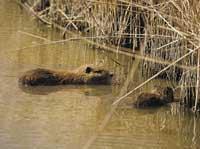Koipua, last Indian

Unfortunately, over the past few years we have often heard the decline of numerous European mammal species. This is the case of the bear, lynx and otter. Therefore, it may surprise us to know that today in Europe there are more species of mammals than at the beginning of the century. How is it possible?
At the same time that some native species of fauna have enormous difficulties in living, especially due to the loss of the habitat in which they live, other imported species can find suitable uncolonized ecological niches and extend them in the new medium. One of the latter is the story (Myocastor coypus).

The body of this large rat shaped rodent, originally South American, has a length of 38-65 cm, to which we must add another 30-45 cm tail. The weight is usually 5 to 8 kg.
The head is similar to the rattlesnake and, like a good rodent, the tale has large and remarkable tusks. These orange teeth from the outside can feed and protect themselves from their enemies.
The valuable skin of this animal has a rough and long coat above, but below these solid hairs, has a careful and very fine woolly coat. Once this hair is cleaned and combed carefully and manually, a gland rubs with the fat produced to make it waterproof.
As for coloring, the coat is usually gray brown, being lighter below. In addition to these typical colors, there are other black and white varieties.
At the bottom the suit is formed by a long thick and scaly tail, but unlike beavers that could be similar, it is cylindrical-conical and unflattened.
The fingers of the hind legs are joined by membranes and are very suitable for swimming. This tells us how his way of life is: it is the year. It inhabits wedges, wetlands, swamps, rivers and waterways stagnant, rarely and hardly moves away from water. It is a good swimmer, which alternately moves the hind legs and is supported with the tail. On dry land, however, it is quite clumsy.
Koipua originally lives in the southern territories of the Tropic of Capricorn (southern Brazil, Argentina, Chile, Paraguay and Uruguay), especially in rivers of dense vegetation. Due to the enormous value of the skin, up to 1910 were exported annually 10 million hides, a figure that was reduced to 200,000 hides. Therefore, it practically disappeared in the places of origin and remains scarce, especially in the places of furtivism.
After breeding on farms in the 1920s, he moved from South American lands to numerous places in the world for economic exploitation. It reproduces in North America, Europe, Russia, the Middle East, Africa and Japan. In the European case, fat nurseries were installed in the Netherlands, Belgium, Germany, France and Italy.

The production of these nurseries was enormous and, for example, in Germany in the 1930-40s there were a thousand nurseries, with an annual production of 100,000 skins. In recent years and due to the change of fashion, it seems that leather production has decreased.
The animals escaped from these nurseries formed wild colonies in many places, reaching Euskal Herria. They have been seen in the Bidasoa-Baztan area and in the North Basque Country.
In our region, these rodents live in slow, plant-rich rivers. Here they feed on different carrizales and herbs from the riverbank, forming a diet with some mollusc and a root.
In these habitats they inhabit small colonies formed by couples or a male and 2-4 females, building 20 cm tall galleries as shelter and mobility. Throughout the day they remain in these galleries and usually do not leave until dusk. On the other hand, in the winter zone, when temperatures drop, there is no environment for the indiano, which is warmer, and moves more during the day.
It may have heat throughout the year and the female will look like 4 to 6 children in a moat once or twice a year. The young are born quite advanced, with open eyes and hair dresses, and lactation lasts between 8 and 14 weeks. Because the female's breasts are located at the top of the rib, some authors have considered it as a molding to feed the offspring during swimming, although they normally feed in the nest.
Apparently, the story does not bear a cold climate and in the harsh winters many specimens die to the north and its extension to the mountain has been limited.
However, although climate is an important factor of mortality, cotales, especially juveniles, can also be food for different predators. Dogs, foxes, mustelids, myrtle and eagles can catch them. The tale, however, tries to despair his enemies with his nails and eyelids erect in an upright position, throwing terrible teeth. Other times it is submerged if any danger is detected and remains hidden for up to 5 minutes.
Finally, the human also captures cotales with traps, especially when he has a great fondness for vegetables, carrots and other vegetables in the orchards. If the next day someone tells us that he has seen a rat like the cat… we will have to believe it. Who knows?
Species: Myocastor coypus Family: myoastodes Order: rodents Class: mammals |





